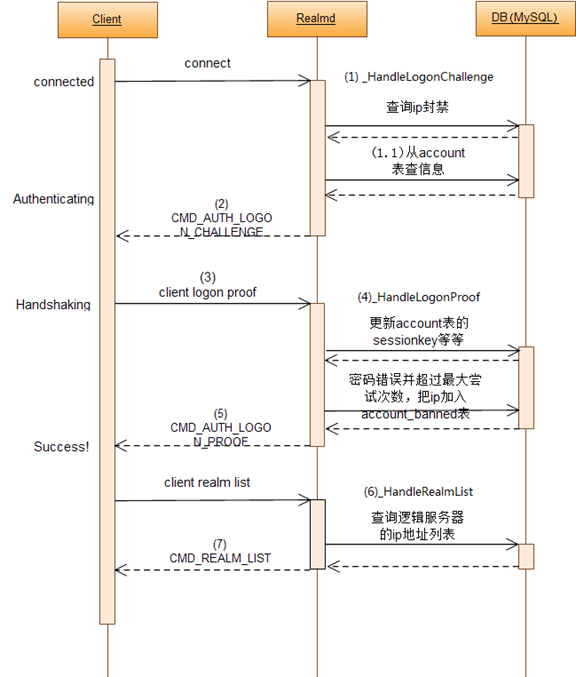在MaNGOS-Zero中认证登录服务器是已独立的进程存在的,名字叫realmd,这样命名可能是和游戏client端根目录下的realmlist.wtf文件相对应。realmd的主要工作是:检查登录用户的合法性,并在合法的情况下完成通信密钥的交换,最后把游戏逻辑服务器的地址信息列表传给client端。
realmd认证的基本流程如下:

图中的(1)~(7)详细过程如下:
(1)Client启动后立即尝试连接realmlist.wtf文件中指定的认证服务器,就发送LogonChallenge给认证服务器realmd。协议结构如下:
1: typedef struct AUTH_LOGON_CHALLENGE_C
2: { 3: uint8 cmd; //Cmd is the command/operation code of the packet. Always 0 for this message
4: uint8 error;
5: uint16 size; //Size of the remaining part of the message
6: uint8 gamename[4]; //4 byte C-String, containing the String "WoW\0"
7: uint8 version1; //Major version number of the client ( 1 for 1.12.1 )
8: uint8 version2; //Minor version number of the client ( 12 for 1.12.1 )
9: uint8 version3; //Patchlevel version number of the client ( 1 for 1.12.1 )
10: uint16 build; //Build number of the client. ( 5875 for 1.12.1 )
11: uint8 platform[4]; //Platform the client is running on, reversed C-String ( "68x\0" for x86 )
12: uint8 os[4]; //OS the client is running on, reversed C-String ( "niW\0" for Windows )
13: uint8 country[4]; //Locale of the client, reversed C-String ( "SUne" for enUS )
14: uint32 timezone_bias;
15: uint32 ip; //IP address of the client in binary format
16: uint8 I_len; //Length of the Identity ( user name ) in characters
17: uint8 I[1]; //The Identity string ( user name )
18: } sAuthLogonChallenge_C;
uint8 I[1]是一个unsigned char的变长数组的头指针,保存user name,服务器端保存的时候要把\0后面的东西去掉,防止SQL injection。(1.1)执行“SELECT sha_pass_hash,id,locked,last_ip,gmlevel,v,s FROM account WHERE username = '%s'”语句从数据库中读取数据。
realmd收到sAuthLogonChallenge_C协议后处理步骤如下:
1) 检查该ip是否被封禁,如果是发送相应的错误
2) 查询数据库中是否有该账户,如果没有返回相应的错误
3) 查看最后一次登录ip与账户是否绑定,如果绑定对比当前ip与last_ip是否一致
4) 检查该账号是否被封禁,如果是发送相应的错误信息
5) 获取用户名密码,开始SRP6计算,参见本文最下方的附录《MaNGOS所使用的SRP6算法》
6) _accountSecurityLevel,保存用户的权限等级,普通用户、GM、admin等等
7) 本地化:根据_localizationName的名字找对应的.mpq文件所在的位置比如enUS,zhTW,zhCN
(2) realmd向client发送challenge,协议如下:
1: typedef struct
2: { 3: uint8 cmd; //Cmd is the command/operation code of the packet. Always 0 for this message.
4: uint8 error;
5: uint8 unk2; //random value
6: uint8 B[32]; //B is an SRP6 value. It is the server's public value.
7: uint8 g_len; //Length of the SRP6 g value we send the client in bytes. Always 1
8: uint8 g[1]; //The SRP6 g value we send the client. Always 7
9: uint8 N_len; //Lenght of the SRP6 N value we send the client. Always 32
10: uint8 N[32]; //The SRP6 N value we send the client.
11: uint8 s[32]; //The SRP6 s value
12: uint8 unk3[16]; //a randomly generated 16 byte value.
13: uint8 unk4; //a single byte 0.
14: } sAuthLogonChallenge_S;
(3)客户端的Handshaking阶段,client为了回应realmd的challenge消息,证明client的密码和server上保存的密码一致,需要计算M1值,并发送给realmd,发送的协议如下:
1: typedef struct AUTH_LOGON_PROOF_C
2: { 3: uint8 cmd; //Cmd is the command/operation code of the packet. Always 1 for this message
4: uint8 A[32]; //The client SRP6 A value ( public client value ).
5: uint8 M1[20]; //The client's SRP6 M value.待比较的最终值
6: uint8 crc_hash[20]; //doesn't seem to be used
7: uint8 number_of_keys; //It also seems to be always 0
8: uint8 securityFlags; // 0x00-0x04
9: } sAuthLogonProof_C;
计算公式如下,各个变量的含义请查看本文最下方的附录《MaNGOS所使用的SRP6算法》
A = g^a mod N //a为19个字节的随机数
B = (kv + g^b) mod N
u = H(A, B)
x = H(s, p)
S = (B - kg^x) ^ (a + ux)
K = H(S)
M = H(H(N) xor H(g), H(I), s, A, B, K)
上诉的哈希函数H都使用的是SHA1
(4)realmd收到client发来的Proof协议,(a)开始检查版本是否允许,(b) 使用SRP6计算M值,与client传过来的M1做对比,if (!memcmp(M.AsByteArray(), lp.M1, 20)) { } (c) 如果M值相等计算K —— 即sessionkey,并最终保存到数据库。
(5)验证成功,realmd向client发送server的logon proof
1: typedef struct AUTH_LOGON_PROOF_S
2: { 3: uint8 cmd;
4: uint8 error;
5: uint8 M2[20]; //The SRP6 M values,M = H(H(N) xor H(g), H(I), s, A, B, K)
6: uint32 unk1; // AccountFlags (trial 0x08, ProPass 0x800000, gm 0x01)
7: uint32 unk2; // SurveyId
8: uint16 unk3; // some flags (AccountMsgAvailable = 0x01)
9: } sAuthLogonProof_S;
(6)_HandleRealmList,查询realmcharacters表获得角色和realmid的对应关系,然后可以在RealmList类里通过realmid找到对应的表项,RealmList在初始化的时候再realmlist表里读取数据放在内存里使用:“SELECT id, name, address, port, icon, realmflags, timezone, allowedSecurityLevel, population, realmbuilds FROM realmlist WHERE (realmflags & 1) = 0 ORDER BY name ” 查询逻辑服务器。
(7)发送realmlist给客户端,客户端选择对应的服务器后点击enter world的时,会主动断开和realmd的连接。
总结:整个登录认证过程主要干了如下几件事
(a)使用公钥算法验证client的合法性。
(b)client合法的情况下,计算sessionkey并保存在MySQL里,以备后面的逻辑服务器使用。
(c)验证通过后,把逻辑服务器列表发给client。
其中最为重要的就是在验证合法性、交换密钥的过程中,如何在传递的协议里隐藏client的密钥,使其在被截获的情况下也无法被黑客解析,这就只能依仗密码学了。WOW所使用的加密算法是SRP6,详细的介绍如下:
附录:MaNGOS所使用的SRP6算法
SRP全称Secure Remote Password(安全远程密码).使用SRP的客户机和服务器不会在网络上传送明文密码,这样可以消除直接密码嗅探行为,另外使用高强度的算法保证了不可能使用字典法攻击嗅探到的数据[1]。SRP协议的描述见 http://srp.stanford.edu/design.html
SRP6名词解释:
N - A large safe prime (N = 2q+1, where q is prime) All arithmetic is done modulo N.
g - A generator modulo N
k - Multiplier parameter (k = H(N, g) in SRP-6a, k = 3 for legacy SRP-6)
s - User's salt
I - Username
p - Cleartext Password
H() - One-way hash function
^ - (Modular) Exponentiation
u - Random scrambling parameter
a,b - Secret ephemeral values
A,B - Public ephemeral values
x - Private key (derived from p and s)
v - Password verifier
对应MaNGOS的计算方法和变量含义:
sha_pass_hash:使用这个函数进行Sha1Hash哈希std::string AccountMgr::CalculateShaPassHash(std::string& name, std::string& password)后得到的值。
N: A large safe prime (N = 2q+1, where q is prime), All arithmetic is done modulo N. 在MaNGOS里N被设成N.SetHexStr("894B645E89E1535BBDAD5B8B290650530801B18EBFBF5E8FAB3C82872A3E9BB7");
s: 32个字节的随机数,算过一次后保存在数据库里。
x: 计算v值使用到的x,即私钥是s与数据库里的sha_pass_hash的倒置的Sha1Hash
v: g^x mod N,验证密码时使用Password verifier,算过一次后保存在数据库里。
g: g = 7
b: 为19个字节的随机数,每次client连接认证的时候重新生成。
a: 19个字节的随机数,由客户端产生。
B: 公钥, gmod = g^b, N , B = ((v * 3) + gmod) % N
K: 认证通过后最终保存到数据库里的sessionkey,(1)计算A 客户端公钥A = g^a mod N a为19为随机数,(2)计算x,x = sha(s, I),I = sha(“username : password”); (3)计算u,u = sha(A, B) //(服务公钥,客户公钥);(4)计算S,S = (B - g^x*3)^(a+u*x); (5)计算K,S为32位,K为40位是 sha(s奇部分)20位, sha(s偶部分)20位的奇偶交错组合。
M: 20个字节的数,用于与client传过来的最终结果M1进行对比,如果M和M1每个字节都相等则验证通过。计算方法:t3 = sha(N)[i] ^ sha(g)[i],t4 = sha(username),M = sha(t3,t4,s,A,B,K)
k: k = 3
总结:服务端,客户端各自计算S的公式个不同,公钥部分服务端用A,b, 客户端用B,a 但其计算结果相同………私钥x被很好的隐藏了,因为想从M获得x是基本不可能的!基于数学难题基础上的加密算法确实很给力。
References:
[1]http://blog.csdn.net/lfhfut/article/details/1124768
[2]http://www.arcemu.org/wiki/
[3]http://hi.baidu.com/zyy503950958/blog/item/3addce90a91eda81a877a463.html